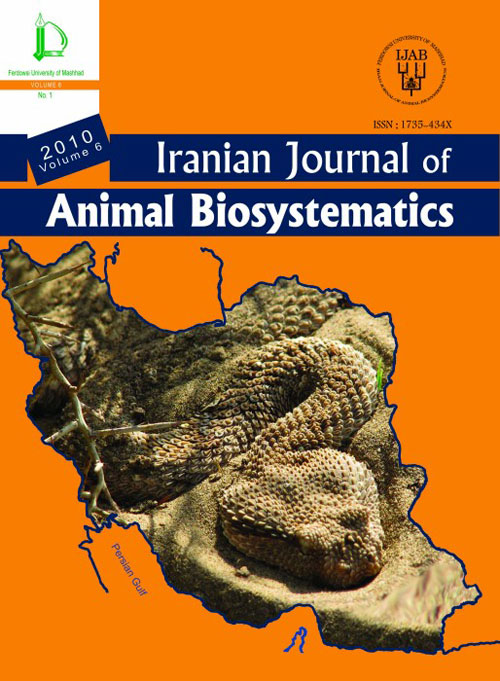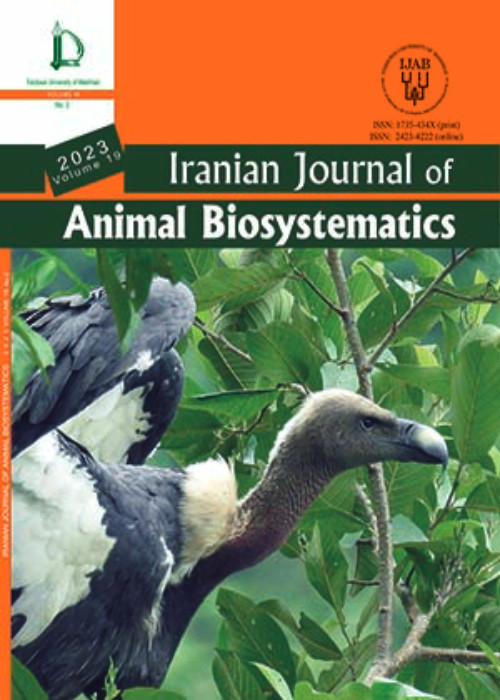فهرست مطالب

Iranian journal of animal biosystematics
Volume:11 Issue: 1, Winter-Spring 2015
- تاریخ انتشار: 1394/08/12
- تعداد عناوین: 11
-
-
Pages 1-6A survey on parasitic copepods was carried out on Pampus argenteus Euphrasen, 1788 in Hormozgan province. Totally, 62 specimens were caught by bottom trawl from northwest of Qeshm Island in summer 2010 and winter 2011. These were immediately frozen in on-board deep freezer of fishing vessel. All samples were transferred to laboratory and after measuring fish weight and length, parasitological survey implemented by stereo-and light microscopes on body surface and gill cavities of the host. Individuals belong to two species of parasitic copepods were removed from the inner surface of the operculum and gill filaments of the host. The collected parasites were Nothobomolochus triceros (Basset- Smith, 1898) and Paralebion aliuncus (Rangnekar, 1955). The prevalence, mean intensity and abundance of parasites were as follows: N. triceros (6.45%, 0.8 ± 0.71 and 0.06) and P. aliuncus (1.61%, 0.2 ± 0.17 and 0.01), respectively. Both species of copepod parasites are reported, for the first time, from Iran.Keywords: Crustacean parasites, Copepod, Qeshm Island, Silver pomfret
-
Pages 7-16The Bedriaga''s Plate-tailed Gecko, Teratoscincus bedriagai, Nikolsky, 1900 is distributed in the northern and eastern deserts of Sistan, Iran and the desert regions of southern Afghanistan. In this research, the male reproductive cycle of this lizard has been studied from 5 April to 5 August, 2013. Totally, 40 adult males were collected by hand at midnight from four adjacent stations in Damghan County, Semnan Province of Iran. Most of the lizards were observed on highly saline, loose soil covered with a thin salt crust, and were common near Tamarix bushes. Animals were transferred to the laboratory and their morphometric characters were measured. After anesthetizing the animals, their testes were removed and processed for morphometric and histological studies. Results showed that the spermatogenesis started after hibernation from early April and ended in August. The peak of spermatogenesis was in May. The numbers of seminiferous tubules were 24-75 and their diameter varied between 72.50 and 232.50 microns. The diameter of tunica albuginea varied between 3.05 and 8.20 microns and diameter of germinal layer varied between 20.40 and 124.30 microns. Spermatogenesis of T. bedriagai in Iran is seasonal and alternates with associate type.Keywords: Spermarogenesis, testes, lizard, gecko, Teratoscincus bedriagai, Iran
-
Pages 17-22We investigated sexual size dimorphism in the tree frog, Hyla savignyi using 33 males and 22 females from the western and northwestern regions of Kermanshah Province, western Iran. Out of sixteen measured morphometric characters, four were significantly larger in females than in males. These characters were nostrileye length, brachium length, elbowlongest finger length and hind limb length.Keywords: Hyla savignyi, sexual size dimorphism, Kermanshah Province, western Iran
-
Pages 23-31The updated checklist of amphibians and reptiles of Qom Province, Central Iran is presented. Totally 46 species, 35 genera and 17 families of reptiles and amphibians are reported in the area. The most diverse suborder is serpentes with 19 species or 41.3% of the reptile species richness of the region. The most specious families with high diversification are ranked respectively: Colubridae with 11 species (23.91%), Agamidae (seven species, 15.21%), Lacertidae and Gekkonidae (each of which with five species, 10.86%), Scincidae (four species, 8.69%), Natricidae and Viperidae (each of which with two species, 4.3%), Bufonidae, Ranidae, Geoemydidae, Testudinidae, Anguidae, Varanidae, Typhlopidae, Erycidae, Lamprophiidae and Psammophiidae with a single species of each.Keywords: Herpetofauna, Qom, type species, record, taxon
-
Pages 33-42In order to improve the knowledge of the Caelifera species of north eastern Iran, faunistic investigations on grasshoppers of this region were carried out during 2013-2014. Collected specimens as well as deposited specimens in Insect Museum of Ferdowsi University of Mashhad were examined, in detail. Totally 19 species belonging to 17 genera, 9 subfamilies and 3 families were collected and determined. Among them Paranocarodes straubei is newly recorded for the fauna of Iran. In addition to faunistic records, differences in species diversity and captured numbers upon time of day were investigated via sweep sampling at two rangeland sites during 2013-2014. There were no significant differences among capture rates in various day hours; so standardized grasshopper sampling could be done between the hours of 8:00 and 16:00 to generate consistent estimates of rangeland grasshopper densities.Keywords: Caelifera, fauna, Iran, Khorasan, e, Razavi, Orthoptera
-
Pages 43-49The karyotype of pike from Anzali lagoon in the south Caspian Sea basin have been investigated by examining metaphase chromosomes spreads obtained from gill epithelial and kidney cells. The chromosomes spreads were stained with 7% Giemsa solution for 15 min and examined under a light microscope. Appropriate metaphase plates were photographed in order to prepare karyotype. All specimens had a diploid number of 50 chromosomes, with a karyotype constituted by 12 metacentric, 24 submetacentric, 14 subtelocentric and fundamental number (NF) of 86. The largest chromosome in this species was a pair of metacentric chromosomes. Based on type of chromosomes, the karyotype of the species differed from the findings of previous studies, which could be attributed to the existence of different populations for this species. Despite the conserved diploid number, the data on the karyotype structure help characterize the cytogenetic profile of this species.Keywords: Esox lucius, Caspian Sea, Cytogenetic, Giemsa staining
-
Pages 51-56Six species of rove beetles (Coleoptera: Staphylinidae), belonging to the genus Philonthus Stephens 1829, are reported for the first time from Iran. They include Philonthus juvenilis Peyron, 1858, Philonthus micans (Gravenhorst, 1802), Philonthus spinipes Sharp, 1874, Philonthus longicornis Stephens 1832, Philonthus viridipennis Fauvel 1875, and Philonthus wuesthoffi Bernhauer 1939. All specimens were collected from Mazandaran province, north of Iran during 2012-2014. An updated checklist of this genus, including 43 species, has been provided.Keywords: rove beetles, Staphylinidae, Staphylininae, Iran, Mazandaran, Philonthus
-
Pages 57-63During a comprehensive study of the genus Stenus (Staphylinidae) along streams and river banks in Iran, some ground beetles (Carabidae) were also collected. In the high mountain areas along the Iranian-Turkish border in the province of Azarbayan -e Gharbi, a Nebria and a Deltomerus species were found. These Nebria and Deltomerus species were clearly different from known Iranian species, but related to Turkish species. Nebria (Nebria) azarbayanei sp. nov. is compared with the related N. (N.) thonitida Ledoux and Roux 1990. Deltomerus (Deltomerus) veldkampi sp. nov. is compared with the closely related D. (D.) lodozi Ledoux 1976. Differences between these new species and the related species are discussed. Pterostichus cryobioides Chaudoir 1868 and Nebria (N.) mandibularis Bates 1872 are recorded for the first time from Iran.Keywords: Coleoptera, Carabidae, Nebria, Deltomerus, new species, Iran (Azarbayan, e Gharbi)
-
Pages 65-77Calomyscus mystax is endemic to Great Balkhan Mountains in southwestern Turkmenistan. However there have been some inaccurate reports of existing this species in Koprtdagh Mts. and northern Iran, but these were considered as Calomyscus elburzensis and Calomyscus grandis. Phylogenetic analyses on Cytb gene clustered samples from Kopetdagh Mts. in northeastern Iran with one specimen of C. mystax belong to Turkmenistan, and so confirmed them as conspecific. Therefore known range of C. mystax has been extended to more southern regions. Morphometric and geometric-morphometric analyses described some cranium and dental characters which distinguished individuals of C. mystax in north east of Iran and North Khorasan province, in comparison to other analyzed samples from other Calomyscus species.Keywords: Calomyscus mystax, Kopetdagh Mts., northeastern Iran
-
An additional records of Hyalomma marginatum rufipes Koch, 1844 (Acari: Ixodidae) in southwestern and southern Iran with a molecular evidencePages 79-89Hyalomma marginatum rufipes (Acari: Ixodidae) along with three closely related subspecies is considered as marginatum group. The subspecies had proven as main vector of Crimean Congo hemorrhagic fever virus, the cause of human death in Asia, Africa and Europe. This tick is also a vector of parasitic protozoan Theileria annulata, agent of tropical theileriosis in cattle. Nonetheless, taxonomical status of this tick not recognized or confirmed in tick’s fauna of Iran, then we decided to show most taxonomic characteristics and confirm the presence of this subspecies in Iran by molecular methods. Tick specimens were collected from cattle in Manujan township, Kerman province, southern Iran. Specimens were identified morphologically using suitable taxonomical identification keys. The morphologically identified specimens were subjected to molecular studies. Morphological and COI gene analysis clearly confirmed the occurrence of H. m. rufipes in Iran, however, according to ITS2 fragment H. m. rufipes can be the same H. m. marginatum. Thus, it seems that based on most popular molecular markers, H. m. rufipes and its relative H. m. marginatum really should be assigned as a polymorphic species H. marginatum.Keywords: Hyalomma marginatum rufipes, Ixodidae, marginatum group, morphological variation, COI, ITS2, Iran
-
Pages 91-100Khorasan-e-Razavi province in the northeast of Iran possesses varied climatic and geographical conditions that lead to a rich biodiversity. An investigation on the status of the fish fauna was carried out from March to October 2013. A total of 401 specimens was collected and identified, from 30 localities among seven counties in this province. Sampling was performed using hand net, cast net and electrofishing equipment. The collected specimens represented two families, seven genera and nine species including Cyprinidae (Capoeta capoeta, Capoeta fusca, Schizothorax pelzami, Alburnoides eichwaldii, Squalius cephalus, Garra rossica, Pseudorasbora parva) and Nemacheilidae (Paraschistura cristata and Paraschistura turcmenica). The Cyprinidae with seven species, showed the highest diversity among the families represented here.Keywords: Khorasan, e, Razavi province, fauna, fish, Iran


